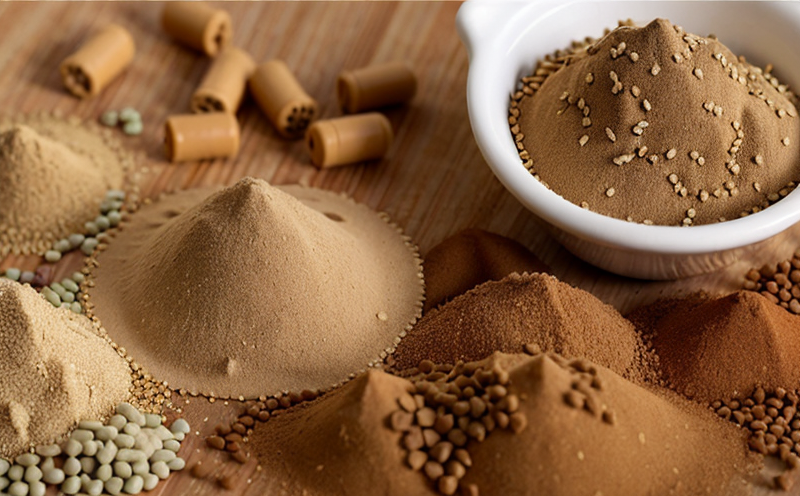Penicillin Residue Testing in Animal Feed
The presence of penicillin residues in animal feed is a critical concern for agriculture and forestry testing. Ensuring that these residues do not exceed safe limits is essential to protect the health of livestock, maintain consumer confidence, and comply with international standards.
Penicillins are a class of antibiotics widely used in veterinary medicine due to their broad-spectrum activity against Gram-positive bacteria. They can enter animal feed through various means, including direct administration or contamination during processing and storage. Detecting penicillin residues is crucial for the following reasons:
- To prevent antibiotic resistance in livestock
- To safeguard public health by avoiding transfer of antibiotics to humans via food products
- To uphold regulatory compliance with international standards
The testing process involves several steps, starting from the collection and preparation of feed samples. Samples are typically taken from various points in the production chain to ensure a representative sample. Once collected, these samples undergo thorough processing, which may include homogenization, extraction, and concentration.
Several analytical techniques can be employed for penicillin residue testing:
- HPLC (High Performance Liquid Chromatography): This method is highly sensitive and selective, making it ideal for detecting low levels of penicillin residues in feed. It separates the components of the sample based on their retention times.
- LC-MS/MS (Liquid Chromatography tandem Mass Spectrometry): Combining liquid chromatography with mass spectrometry offers greater specificity and accuracy, making it a preferred choice for detecting penicillin residues.
The analytical method must follow stringent protocols to ensure accurate results. The process includes calibration of instruments using standard solutions, quality control measures like spiked samples, and rigorous validation steps as per relevant standards.
Accurate and reliable testing is paramount in the agriculture sector. Regulatory bodies worldwide enforce strict limits on penicillin residues in animal feed. For instance:
- United States: The FDA sets tolerance levels for various antibiotics, including penicillins.
- European Union: EU regulations specify the maximum residue limits (MRLs) for veterinary drugs.
The importance of these MRLs cannot be overstated. Exceeding these limits not only poses health risks but also leads to product recalls and potential legal consequences. Therefore, laboratories must adhere strictly to international standards like ISO 17025 for accreditation and ensure that their methods are validated against established guidelines.
Applied Standards
| Standard | Description |
|---|---|
| ISO 17025 | Accreditation criteria for testing and calibration laboratories. |
| ASTM E1698 | Multiplexed immunoassay methods for the determination of penicillin G in feeds by liquid chromatography-tandem mass spectrometry (LC-MS/MS). |
| EN 34720:2015 | Determination of penicillin residues in feed materials and animal products. |
| IEC 62321 | Testing methods for the determination of penicillin G in feed by liquid chromatography-tandem mass spectrometry (LC-MS/MS). |
The laboratory must stay updated with these standards to ensure that testing protocols are current and comply with international best practices. This includes regular calibration, method validation, and participation in proficiency testing programs.
International Acceptance and Recognition
The acceptance of penicillin residue testing results is critical for ensuring the integrity of the global food supply chain. Many countries recognize accredited laboratories that follow international standards. For example:
- United States: Laboratories must be certified by the USDA or equivalent bodies.
- European Union: Recognition is through EU directives and relevant national authorities.
International recognition ensures that test results are accepted across borders, reducing the likelihood of trade disruptions. Compliance with these standards also enhances a laboratory's reputation, making it more attractive to clients seeking reliable testing services.
The widespread use of penicillin in animal feed necessitates stringent testing protocols. Laboratories play a crucial role in safeguarding public health by ensuring that residues do not exceed safe limits. This is achieved through rigorous testing methods and adherence to international standards.
Environmental and Sustainability Contributions
- Reduction of Antibiotic Resistance: By detecting penicillin residues, laboratories help prevent the spread of antibiotic resistance in livestock. This contributes to healthier ecosystems and reduces the need for stronger antibiotics.
- Consumer Confidence: Ensuring that animal feed is free from excessive penicillin residues builds trust with consumers, who are increasingly concerned about the quality and safety of their food.
- Sustainable Practices: By maintaining compliance with international standards, laboratories contribute to sustainable agricultural practices. This includes efficient resource use, reduced waste, and lower environmental impact.
The detection of penicillin residues in animal feed is not just about regulatory compliance; it is a vital step towards promoting sustainability and public health. Laboratories play an essential role in this process by providing accurate and reliable testing services.





